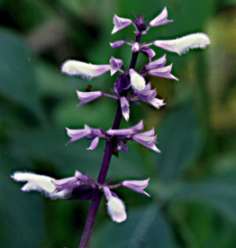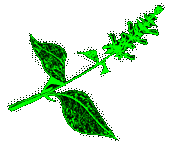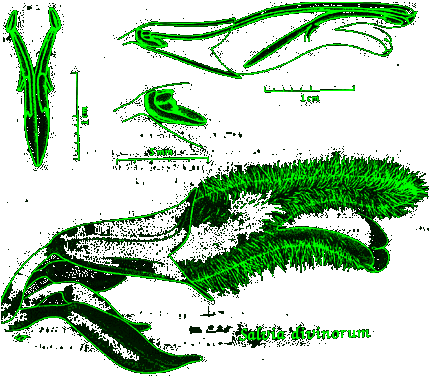What is it?
Salvia Divinorum is a powerful and sacred plant with curative powers and extraordinary mind-altering effects.
| Kingdom | : | Plantae |
| Division | : | Magnoliophyta |
| Class | : | Magnoliopsida |
| Order | : | Lamiales |
| Family | : | Lamiaceae |
| Genus | : | Salvia (from the Latin salvare, to heal) |
| Species | : | divinorum |
Salvia Divinorum is a species of Sage which is a member of the Lamiaceae family of plants (originally called Labiatae), which also include such familiar herbs as oregano, thyme and basil as well as many other well known ornamentals. As Sages are members of the mint family, Lamiaceae, Salvia Divinorum is sometimes referred to as a mint or Mexican Mint due to its Mexican origin.
Traditionally Salvia Divinorum has been used in initiation and facilitation of shamanic practice by Mazatec Indians of the Sierra Mazateca region of Oaxaca, Mexico. They refer to it by a number of names, most commonly 'Ska Maria Pastora' ('leaves of the Virgin Mary, the Shepherdess'). As well as being used as a tool for divination such as general problem solving and finding lost objects, Salvia Divinorum has been used in healing ceremonies and for the treatment of disease.
Translated the biological name of Salvia Divinorum becomes “Sage of the Diviners” or “Diviners Sage” which is how the Mazatec Indians of the Northern Mountains in Oaxaca, Mexico have used it for hundreds of years due to its ability to provide an experience which has been described as a divine state of awareness.
Salvia Divinorum was unheard of in western culture until 1962 when R. Gordon Wasson received a sample of the plant from a Mexican curator and took it to the United States where it was passed on to Carl Epling and cloned and cultivated at the University of California in Los Angeles. Salvia Divinorum still remained almost unknown by most Westerners until the appearance of a New York Times article in 2001 created an interest in the plant as a legal hallucinogen.
There are no known areas in the world where it grows naturally in the wild. At first glance, populations of Salvia Divinorum in the Oaxaca Mountains seem to be natural though this is due to the natives planting it in out of the way places. Once established in the right conditions salvia will spread asexually as stem sections quickly take root when they come in contact with the moist soil.
It is rare that the plant produces seed and if it does there is usually only a small chance that the seeds will be viable it also has no known natural pollinator. It is for this reason that most of the plants reproduction is performed asexually by cloning by enthusiasts and naturally in the wild and is therefore known as a cultigen.
The Salvia Divinorum plant has hollow, square stems with winged edges. It is an interesting observation to be made when viewing the top of a cross section cut that it reveals a "Circle in the Square" image. The stems are not very sturdy and usually only grow a few feet, without support, and then break off. If the conditions are right, by sending out roots where it touches the ground, the broken stem may grow a new plant or plants. This is the way it is known to propagate in the wild.
See : The Botany of Salvia Divinorum (Labiatae)
 http://www.sabia.com/salvia/index.html
http://www.sabia.com/salvia/index.html

Current use in the Western World
A new awareness of Salvia Divinorum in the West has been spurred on by the media’s demonising of it in various news stories, likening it to marijuana or LSD, which it is not. These stories usually have the reverse effect of what they are trying to achieve, they usually make the “drug” in question seem more romantic and enticing.
Fascinated by stories of its hallucinogenic properties, many people have looked towards Salvia Divinorum as an alternative legal high only to discover that it has much more to offer than that. For most people though, the Salvia Divinorum experience is far too much for them to grasp and often never go past the initial experimental try.
There is enough supportive evidence to show that only a small number (around one in ten) of individuals who try Salvia Divinorum will return to it. The remaining nine out of ten usually say they will never use Salvia Divinorum again and were usually the people looking for an alternative drug/high. This follows along with most experiments with hallucinogenic plants from Psilocybin mushrooms to Datura flowers and is also strong evidence to show that Salvia Divinorum is not a substance that has potential for abuse.
People who share a relationship with Salvia Divinorum claim those who try it once and are “scared” away do not have the necessary mind skills to be able to blend with its full experience and learn from it and. Those that use Salvia Divinorum past the first experiment usually develop a deep respect for the plant and its effects and liken them more to a meditation session than to a getting high experience.
The most common method of consuming Salvia Divinorum is by smoking the leaves or a more potent leaf extract, which brings about an hallucination period of anywhere between 1 to 10 minutes only. The whole effect wares off in an hour. See our : Using Salvia Divinorum Page
Known Medical applications
Salvia comes from the Latin salvare, to heal
Traditionally, natives to Oaxaca Mexico have used Salvia Divinorum for healing patients and divination. It has been reputably used to aid headaches, migraines, stomach upsets, constipation, diarrhoea, colds, sore throats and other ailments.
There are no accepted medical uses of Salvia Divinorum within Western medicine practice at this time. Exploration into possible use suggests that the traditional Mazatec use is quite good at treatment for many of the ailments mentioned above. There is also strong anecdotal evidence to support the usefulness of Salvia Divinorum in resolving pathological grief and as an antidepressant.
See : Salvia divinorum: Clinical and Research Potential Karl R. Hanes, Ph.D.
 http://www.maps.org/news-letters/v13n1/13118han.html
http://www.maps.org/news-letters/v13n1/13118han.html

Should Salvia Divinorum be Restricted or Prohibited?
NO!
The knee-jerk reaction of Governments and Civic Action Groups to ban Salvia Divinorum or restrict its use is due to their uneducated perception that Salvia Divinorum is another "evil weed/drug" that is going to steal or destroy the minds of their innocent gullible youth.
Media portrayal over the past few years has also shown gross inaccuracies and misinformation about the effect of Salvia Divinorum and frequently refer to it as a new marijuana or LSD, which it is not.
People like Senator Richard Devlin of the state of Oregon (U.S.A) who has gone on record as saying "We must use every means available to get this substance off the market before one more child is harmed by it", have used uninformed fear about Salvia Divinorum to promote their own political ambitions.
It does not seem to matter to Senator Richard Devlin that there are in fact no records of a single child being harmed by it instead he appears to be quite happy to deceive his electorate with fear mongering to bolster his own image as a do-gooder.
In February 2003, Devlin introduced Senate Bill 592 which made it a crime to sell, give, or otherwise make Salvia Divinorum available to minors. Violating the law would be a Class A misdemeanour. This Bill was removed in September 2003 after further information was offered about Salvia Divinorum, in particular the Centre of Cognitive Liberty (CCLE)'s Salvia Divinorum Report.
It was the same display of misguided fear of Salvia Divinorum as an hallucinogen that allowed the incorrect guesswork of a drug enthusiast’s 1995 post in an "alt.drugs" Internet chatroom to be copied (without acknowledgement) and pasted into the Australian law banning Salvia Divinorum in June 2002. See : Australian Law Page
|
Even The Bible Condemns Prohibition as Blasphemy!
|
|
There is a beautiful irony created when people refer to any plant as an "Evil weed". The statement is usually made by a person or persons who often repressent religious organisations or values. It is actually a "religious Law" that states no one may judge any of Gods creations as to do so is blasphemy and "punishable by death".
 The whole story : http://killdevilhill.com/z/yfired/KingJamesBiblehall/cas/7.html The whole story : http://killdevilhill.com/z/yfired/KingJamesBiblehall/cas/7.html
|
Salvia Divinorum Photos by Daniel Siebert(leaves) and Will Cook(flowers)
Flower drawings - Originals By Lucy Taylor [commissioned by Aaron Reisfield](see: Original)
|




